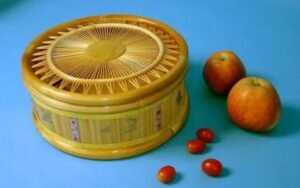Bamboo handicrafts are not just ordinary items; they are a beautiful blend of traditional craftsmanship and environmental friendliness. Bamboo, known as the “green gold,” has been used for centuries to create a wide variety of handicrafts that are both functional and aesthetically pleasing.

1. The Versatility of Bamboo
Bamboo is a highly versatile material. It can be bent, carved, and woven with relative ease. This makes it suitable for creating everything from simple utensils to complex pieces of art. Bamboo’s natural strength and flexibility allow artisans to shape it into different forms, such as baskets, trays, and even furniture.
2. Rich Cultural Heritage
In many Asian countries, bamboo handicrafts have a long – standing cultural heritage. For example, in China, bamboo has been an important part of traditional handicraft making for thousands of years. It is often associated with elegance, simplicity, and a connection to nature. In Japan, bamboo is used in the creation of traditional tea ceremony utensils, adding a touch of rustic charm.
3. Types of Bamboo Handicrafts
- Basketry: One of the most common types of bamboo handicrafts. Bamboo baskets come in various sizes and shapes, from small handheld baskets for collecting fruits to large storage baskets. They can be plain or intricately designed with patterns.
- Carvings: Bamboo carvings are a form of art that showcases the skills of the artisans. Intricate sculptures of animals, people, or floral designs can be created on bamboo stalks or slices.
- Furniture: Bamboo furniture is not only stylish but also eco – friendly. Chairs, tables, and beds made from bamboo are lightweight, durable, and add a natural touch to any living space.
4. The Art of Bamboo Weaving
Bamboo weaving is a complex and time – consuming process. Artisans start by selecting the right type of bamboo and preparing the strips. These strips are then interwoven to create beautiful patterns. The techniques can vary from region to region, resulting in unique styles of woven bamboo handicrafts.
5. Sustainability of Bamboo Handicrafts
Bamboo is a sustainable resource. It grows rapidly, requiring minimal water and no pesticides. By choosing bamboo handicrafts, consumers are supporting a more sustainable lifestyle. Moreover, the production of bamboo handicrafts often involves traditional, low – impact manufacturing methods, further reducing the environmental footprint.

6. Bamboo Handicrafts in Interior Decoration
Bamboo handicrafts can transform any interior space. A bamboo – woven wall hanging can add texture and warmth to a living room. Bamboo baskets can be used as decorative storage in the bedroom or bathroom. They bring a natural and organic feel to modern interiors.
7. Handmade vs. Machine – made Bamboo Handicrafts
- Handmade: Handmade bamboo handicrafts are unique and carry the mark of the artisan’s skill. Each piece is carefully crafted, with attention to detail. However, they are often more expensive due to the labor – intensive process.
- Machine – made: Machine – made bamboo handicrafts are more mass – produced. They are generally more affordable but may lack the charm and individuality of handmade pieces.
8. Bamboo Handicrafts as Gifts
Bamboo handicrafts make excellent gifts. They are not only beautiful but also meaningful. A bamboo – carved bookmark can be a great gift for a book lover, while a bamboo – made jewelry box can be a special present for someone who appreciates unique items.
9. The Future of Bamboo Handicrafts
With the increasing awareness of environmental issues, the future of bamboo handicrafts looks bright. There is a growing demand for sustainable products, and bamboo handicrafts are well – positioned to meet this demand. However, artisans need to adapt to modern marketing techniques to reach a wider audience.
10. Bamboo Handicrafts in the Global Market
Bamboo handicrafts are now finding their way into the global market. They are being exported to different countries, where they are appreciated for their beauty and sustainability. However, they also face challenges such as competition from synthetic materials and the need to meet international quality standards.
11. Preserving the Traditional Skills
As modernization progresses, it is important to preserve the traditional skills involved in bamboo handicraft making. This can be achieved through training programs, workshops, and support for local artisans. By doing so, we can ensure that this rich cultural heritage continues to thrive.
12. Bamboo Handicrafts and Tourism
In many areas where bamboo handicrafts are produced, they are also an important part of the tourism industry. Tourists are often attracted to workshops where they can see the artisans at work and purchase unique bamboo handicrafts as souvenirs.
13. Bamboo Handicrafts for Outdoor Use
Bamboo is well – suited for outdoor use. Bamboo fences, pergolas, and garden furniture are not only functional but also add a natural beauty to the outdoor environment. They are resistant to weathering and can last for a long time if properly maintained.
14. Custom – made Bamboo Handicrafts
Some artisans offer custom – made bamboo handicrafts. Customers can request specific designs, sizes, or functions. This allows for a more personalized and unique product that caters to individual tastes.
15. Bamboo Handicrafts and Wellness
The natural and organic nature of bamboo handicrafts can also contribute to wellness. For example, using bamboo – made bedding can provide a more breathable and comfortable sleeping experience. Bamboo – fiber towels are also known for their softness and absorbency.
16. Conclusion
Bamboo handicrafts are a wonderful world of art, culture, and sustainability. They offer a wide range of products that can enhance our lives in many ways, from adding beauty to our homes to promoting a more sustainable lifestyle. As consumers, we should support the growth and development of bamboo handicrafts by choosing these unique and eco – friendly products.

Leave a Reply